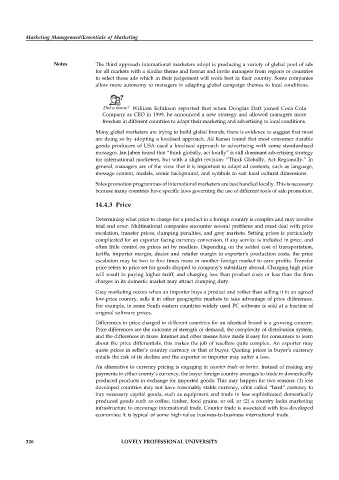Page 333 - DMGT408DMGT203_Marketing Management
P. 333
Marketing Management/Essentials of Marketing
Notes The third approach international marketers adopt is producing a variety of global pool of ads
for all markets with a similar theme and format and invite managers from regions or countries
to select those ads which in their judgement will work best in their country. Some companies
allow more autonomy to managers in adapting global campaign themes to local conditions.
Did u know? William Echikson reported that when Douglas Daft joined Coca Cola
Company as CEO in 1999, he announced a new strategy and allowed managers more
freedom in different countries to adapt their marketing and advertising to local conditions.
Many global marketers are trying to build global brands; there is evidence to suggest that most
are doing so by adopting a localised approach. Ali Kansu found that most consumer durable
goods producers of USA used a localised approach to advertising with some standardised
messages. Jan Jaben found that “think globally, act locally” is still dominant advertising strategy
for international marketers, but with a slight revision: “Think Globally, Act Regionally.” In
general, managers are of the view that it is important to adapt ad contents, such as language,
message content, models, scenic background, and symbols to suit local cultural dimensions.
Sales promotion programmes of international marketers are best handled locally. This is necessary
because many countries have specific laws governing the use of different tools of sale promotion.
14.4.3 Price
Determining what price to charge for a product in a foreign country is complex and may involve
trial and error. Multinational companies encounter several problems and must deal with price
escalation, transfer prices, dumping penalties, and grey markets. Setting prices is particularly
complicated for an exporter facing currency conversion, if any service is included in price, and
often little control on prices set by resellers. Depending on the added cost of transportation,
tariffs, importer margin, dealer and retailer margin to exporter’s production costs, the price
escalation may be two to five times more in another foreign market to earn profits. Transfer
price refers to price set for goods shipped to company’s subsidiary abroad. Charging high price
will result in paying higher tariff, and charging less than product costs or less than the firm
charges in its domestic market may attract dumping duty.
Grey marketing occurs when an importer buys a product and rather than selling it in an agreed
low-price country, sells it in other geographic markets to take advantage of price differences.
For example, in some South eastern countries widely used PC software is sold at a fraction of
original software prices.
Differences in price charged in different countries for an identical brand is a growing concern.
Price differences are the outcome of strength of demand, the complexity of distribution system,
and the differences in taxes. Internet and other means have made it easy for consumers to learn
about the price differentials, this makes the job of resellers quite complex. An exporter may
quote prices in seller’s country currency or that of buyer. Quoting prices in buyer’s currency
entails the risk of its decline and the exporter or importer may suffer a loss.
An alternative to currency pricing is engaging in counter trade or barter. Instead of making any
payments in either county’s currency, the buyer foreign country arranges to trade in domestically
produced products in exchange for imported goods. This may happen for two reasons: (1) less
developed countries may not have reasonably stable currency, often called “hard” currency to
buy necessary capital goods, such as equipment and trade in less sophisticated domestically
produced goods such as coffee, timber, food grains, or oil, or (2) a country lacks marketing
infrastructure to encourage international trade. Counter trade is associated with less developed
economies; it is typical of some high-value business-to-business international trade.
326 LOVELY PROFESSIONAL UNIVERSITY

